SATHYA SAI BABA'S 'OFFICIAL' BIOGRAPHER AND CLOSE DEVOTEE - N. KASTURI
Use right click here - then 'Open page in new window' to translate
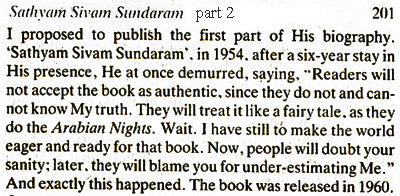 Commissioned as his official biographer by Sathya Sai Baba, Professor N. Kasturi was his utterly devoted servant and had been a teacher of history to pre-university classes for 32 years and an itinerant poet-cum-public speaker before Sai Baba called him permanently to 'His Feet'. His four-volume work 'Sathyam, Sivam, Sundaram' ( or 'Truth, Goodness, Beauty') begun to be published from 1960 onwards, 12 years after he had moved to the proximity of Sai Baba at his ashrams, living mostly in a tiny and modest apartment allocated to him there until his death. See the scan of text on the right, where Kasturi was explaining how Sai Baba had told US author Arnold Schulman, who wrote a book entitled 'Baba', that he told him to write it only because "I want you. I want your faith. I want your love... it is time now for you to stop vacillating" also "Do you believe in me in the same way I said you
have to believe in me?" p. 75 in 'Loving God') Kasturi applied the same words to himself and concluded "It took twelve years for me to approximate a little to the standard of belief He directs us to have..."
Commissioned as his official biographer by Sathya Sai Baba, Professor N. Kasturi was his utterly devoted servant and had been a teacher of history to pre-university classes for 32 years and an itinerant poet-cum-public speaker before Sai Baba called him permanently to 'His Feet'. His four-volume work 'Sathyam, Sivam, Sundaram' ( or 'Truth, Goodness, Beauty') begun to be published from 1960 onwards, 12 years after he had moved to the proximity of Sai Baba at his ashrams, living mostly in a tiny and modest apartment allocated to him there until his death. See the scan of text on the right, where Kasturi was explaining how Sai Baba had told US author Arnold Schulman, who wrote a book entitled 'Baba', that he told him to write it only because "I want you. I want your faith. I want your love... it is time now for you to stop vacillating" also "Do you believe in me in the same way I said you
have to believe in me?" p. 75 in 'Loving God') Kasturi applied the same words to himself and concluded "It took twelve years for me to approximate a little to the standard of belief He directs us to have..."
Prof. Kasturi was a more sophisticated observer and chronicler than many who wrote books worshipful of Sai Baba. He had been a sharp critic of sannyasIns and supposed 'holy men' before he met SB, having been attached to the Ramakrishna Mission, with its scepticism about the use of psychic and yogic powers. The whole approach of Kasturi towards his Sadguru, eventually his every perception, was modelled clearly on the belief induced in him by Sai Baba that he was the one and only full avatar of God in this aeon. Having been a devotee of the long-deceased Hindu guru, Ramakrishna Parmahamsa,
Kasturi was fallow ground for Sai Baba's further indoctrination... not longer dry ritual and doctrine but the exhilaration of experiencing one he regarded as the Divinity itself... a reborn Vishnu, Rama and Krishna. Before he met SB, his entire attitude was already imbued with Indian spirituality and was evidently never quite free from many beliefs and superstitions, which all came to the fore and took over rather fully when his conversion took place. He liked to rationalise all that SB did, both to others and himself, as being trials and tests by SB for the a stripping off of the layers of personal ego, the supposed goal being self-realisation. However, he never thought he had attained any such thing. Under the title of 'The Chiselled Child' (Loving God, p. 335 ff.) he recounted in searing self-investigation the dilapidated state of his own personality and the many and varied failings he had succumbed to by the time he came under SB's guidance at the age of fifty. What he wrote in 1982 can hardly be repeated often enough, for the insights it gives: "And the new Gurudev accepted me just as I was. 'Man has to be unmade and remade,' He has said. I was indeed fortunate to merit His gracious attention and undergo overhaul for three decades and a half. The process is still on and it may have to continue during one or two more lives for aught I know. If SB sends word for me now through someone to go into His Presence, my first reaction is to examine myself in order to discover where I have erred or slipped, which boundary I have transgressed, whom I have hurt or slighted, for, His call is mostly for chiselling."
Kasturi collected every scrap of hearsay from villagers around in Puttaparthi and applied himself to weaving it into a constant eulogy and wordy glorification, making it much more of an enthusiastic and devoted fairy tale than a research, let alone a remotely documented study. As Professor Haraldsson scathingly replied when first we met in Bangalore in 1988 and I innocently praised Kasturi's biography, that it is a most unreliable and far from impartial account. I was quite shocked at Haraldsson's scepticism, but then he had already published his book in which he definitively disproved Sai Baba's claim to have resurrected the US millionaire Walter Cowan.
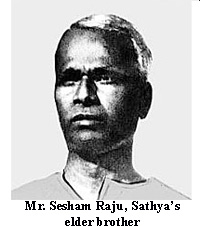 Kasturi's 'biography' of SSB reads like the systematic application of Hindu iconography to Sathya Sai Baba, which greatly weakens its credibility and will surely be seen mostly as second-hand story-telling by religious scholars and researchers everywhere. The mythology is now beginning to fall apart at the base in that central dates and events have been shown not to be in accordance with official school registers or even with the calendar. These are the kind of facts that are of a fundamental and often conclusive nature for historians and objective researchers of all kinds.
Kasturi's 'biography' of SSB reads like the systematic application of Hindu iconography to Sathya Sai Baba, which greatly weakens its credibility and will surely be seen mostly as second-hand story-telling by religious scholars and researchers everywhere. The mythology is now beginning to fall apart at the base in that central dates and events have been shown not to be in accordance with official school registers or even with the calendar. These are the kind of facts that are of a fundamental and often conclusive nature for historians and objective researchers of all kinds.
Sesham Raju, elder brother of Sathya Professor Kasturi, who I met on several occasions and interviewed, was evidently a very naive person without any known research qualifications, though he once held a teaching post as professor of history (without having a Ph.D). In his ‘official biography’ he hardly mentioned the elder brother, Mr. Sesham Raju (born 1911), who lived in Puttaparthi and who Kasturi knew well. Sesham Raju was the only properly educated member of Sai Baba’s family and was well-placed to have known most of what happened, causing him to write a critical letter in 1947 to Sathya. Kasturi only refers to Sathya's arrogant reply - a letter famous among devotees for correcting’ his elder brother and boasting greatly about himself.
Kasturi chose not to report Sesham's highly sceptical views of the claims of Sai Baba and the stories about him. Sesham's letter is never reproduced in Sai Baba literature (surely it would have been too disrupting of the myth), so only Sathya's reply letter is presented - an outwardly 'loving' rebuttal and spposed evidence of SB's prescience as to his own future. Living in Puttaparthi from the 1970s until his death in 1985, Sesham was unwilling (or under great pressures not) to write or speak out in public due to the consequences it would have, both for the Sai empire and no doubt for himself and family. Unfortunately therefore only reports by persons who met him and learned his views are available. Most likely Sathya would have warned Kasturi not to listen to his elder brother, whose evidence would very possibly have destroyed the entire childhood mythology. Kasturi mentions Sesham passing in connection with Sai Baba’s schooling. The shortcoming of this is shown by a report I received from a former security official of Sai Baba's ashram:-
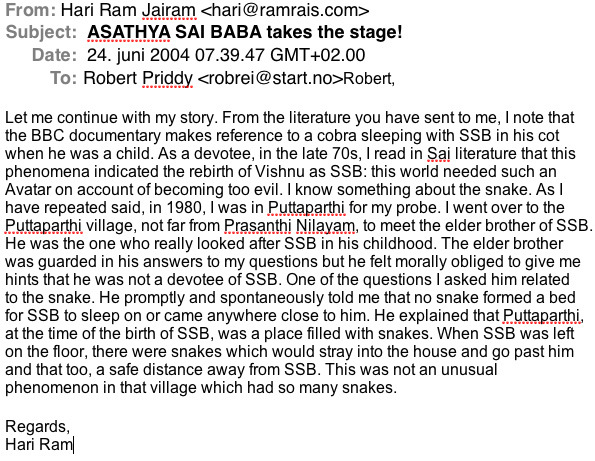
THE RUMOUR MILL AND ITS EDITORS
Kasturi never learned journalistic rigour for, though a teacher of history (never becoming a university professor), he engaged a lot in humour and poetry or in radio causeries on spiritual subjects. The extremes of Kasturi's flowery praise and ultimate support of every claim made by Sai Baba, with never a whiff of critical awareness - combined with Kasturi's own account of his extreme servitude and yet how he was sometimes severely punished by Sai Baba for almost no reason - cause the suspicion that fear and flattery were among Kasturi's personal motives, as was evident in the words and actions of a large number of those aspiring to be among the closest disciples.
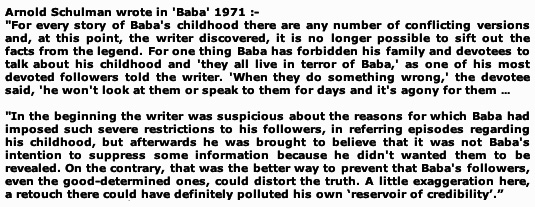 Arnold Schulman wrote of the problems facing anyone who seriously tried to find out the facts about Sai Baba's childhood, showing how this was already a major issue for censorship (and probably misinformation)
before 1971 when Schulman's 'Baba' was published.
Arnold Schulman wrote of the problems facing anyone who seriously tried to find out the facts about Sai Baba's childhood, showing how this was already a major issue for censorship (and probably misinformation)
before 1971 when Schulman's 'Baba' was published.
If the accounts by Kasturi and a few others from the earlier years who were able to question contemporaries of the young Sathya Sai Baba are correct, he behaved as an incarnate deity even as a young man. However, Kasturi overlooked or minimised the significance of the numerous instances by not going into detail on how Sathya Sai Baba was subject to most ordinary social and other limitations (being bullied as a boy, not being accepted by his parents or elder brother as other than a boy and so on, being set away by his family for a long period to work with another family under rigorous conditions). He mostly skirted around anything that could be controversial or cast the slightest suspicion on Sai Baba's veracity. Sathya Sai's younger brother - Janakiramiah - told my close friend V.K. Narasimhan that the parents had terrible difficulties with Sathya Sai Baba as a son for he was so unruly and disobeying. Sathya Sai Baba was a frequent truant at school and was what we typically call a 'drop out'. And this behaviour from one who lays so much weight on respecting and obeying parental wishes! Kasturi's rosy adulation of him as 'Bala Sai' and a reborn mischievous baby Krishna etc. was developed at second-hand, long after Sathya Raju renamed himself Sathya Sai Baba and grew up.
Arnold Schulman had a different view of these stories (click to see source)
Kasturi told Prof. E. Haraldsson that, though he is somehow divine, "Swami is also very human"... seemingly a belated half-admission that Sathya Sai Baba suffers from faults and sins like any other person... for surely Kasturi cannot have failed to encountered lies, sexual proclivities, deceptions and dishonourable avoidance of justice?
I have met a number of prominent Indian persons in the Sai movement, including V.K. Narasimhan, who overlooked the bogus claims of SSB and his ignorance of many matters on the grounds that he was doing good anyhow, spreading good values and achieving more for the local populace and the poor of the region than the government could manage. In India, the circumstances are so overwhelming dreadful for the dispossessed that making compromises - even if they are dishonourable - is accepted if any good at all can come of it.
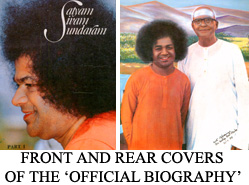 When the top professional ex-journalist V.K. Narasimhan took over from Kasturi, initially in the early 1980s, he was instructed by Sathya Sai not to publish accounts of dreams, healing powers or other miraculous phenomena... the sort of material in which Kasturi had until then literally revelled in - in Sanathana Sarathi, in his 'biography' of Sathya Sai Baba and in his self-effacing autobiography ('Loving God'). Narasimhan managed to stick to this fairly well, with lapses here and there.
When the top professional ex-journalist V.K. Narasimhan took over from Kasturi, initially in the early 1980s, he was instructed by Sathya Sai not to publish accounts of dreams, healing powers or other miraculous phenomena... the sort of material in which Kasturi had until then literally revelled in - in Sanathana Sarathi, in his 'biography' of Sathya Sai Baba and in his self-effacing autobiography ('Loving God'). Narasimhan managed to stick to this fairly well, with lapses here and there.
In later years, and especially after the sex scandal in 1999, when Sai Baba's outreach has become international and his institutions grew increasingly dependent on a flow of donations from followers, the Sathya Sai Organization began to tone down the claims that smacked too much of megalomania and it was considered better in most cases to keep quiet rather than draw more attention to the incredible. It seems that Sathya Sai Baba - through his appointed propagators - eventually accepted the need to sanitize the literature about him. The SS Org. tried, such as through internal directives to national leaders and their members, to suppress the more fantastic claims of Sai Baba - the exorbitant declarations of Supreme Godhead and Creator of the Universe and miracles without limit written about by besotted bhaktas. Web pages were modified or removed and reprints of discourses were more carefully edited, such as to exclude some of the major blunders he made, most probably in the hope that the vast donations would not wither further. This need was dictated by gaining credibility for its work in extending the Sathya Sai Baba influence and the various works they undertake (doubtless mostly with the best of intentions) which increasingly require social acceptance and the public 'blind eye' to the activities of Sathya Sai Baba himself.
A large number of stories that are constantly repeated even today have been shown to be inventions, while many others simply cannot be true because they defy all feasibility. Indeed, there is no limit to what is possible in most Sai devotees' minds, for "Swami is the all-powerful Godhead", which largely would follow from that were it fully believed. The many miracle stories, often embroidered out of subjective experience, misunderstanding and sheer inventions, were the daily bread and wine of a mass of devotees... a fact to which I can attest through my hundreds of conversations with followers from many countries of the world through two decades. Too trusting at first, I came through experience to learn that invented stories were one way of achieving prominence in the Sai Baba movement. The uneducated Indian villager is often unable to distinguish myth from fact, especially with religious stories, which are freely embroidered without any sense of deceiving others. This applied not only Puttaparthi villagers living in grinding poverty and searching for ways to get ahead and be helped by foreign visitors, but also among trusting, educated and too-gullible Westerners. Add to this that Sathya Sai Baba positively throve on rumour and myth (see here)
There are countless baseless rumours, accounts of miracles, 'stories' and the like circulating in the Sai movement, and a number of these were spread through Kasturi's unswerving acceptance of anything Sai Baba or close followers told him. Many unlikely stories about Sai Baba - especially those spread by him personally - are supported and encouraged by Sai Org. office-bearers, and even the wildest fables are tolerated as an enhancement of Sai Baba's fame without any refutation of them. Rumours making Sathya Sai Baba seem much more than he was, are allowed to spread unhindered, while Sai followers and officials frequently denounce as rumours anything that casts a critical light on any of Sai Baba's words or acts. The Sai following imagines itself to be the cream of the world's spirituality, destined to save humanity from catastrophe, and their agenda is to expand their numbers and influence at almost any cost, certainly at the cost of fact and truth.
In my book 'Source of the Dream', ( p. 222f ) I wrote about one of two longish meetings with Kasturi in his apartment at South Prashanthi in January 1987, when I asked him a number of pre-prepared questions which he answered:-
"Sri Kasturi told us that Sathya Sai Baba had himself, almost invariably in Kasturi's presence, personally read and authenticated every one of his discourses published in the monthly journal Sanathana Sarathi since its inauguration by Sai Baba on Shivaratri day in 1968 ...If Baba was dissatisfied with any result of Kasturi's editing (or in later years, Sri Narasimhan's), he would indicate corrections and alterations."
"Until about the mid-1970s, Prof. Kasturi's own notes, taken on the dais while simultaneously translating Baba's words during public discourses, were the only source from which he had to work in preparing the English versions for printed publication." "Only later were sound recordings made of the discourses, with all transcripts and translations being based on these."
"Naturally, a question was included about the accuracy of results from such a rapid process for, as Kasturi pointed out, he never had time to transcribe more than a note or a reminder while these two-hour marathon discourses were under way." (Presumably the notes were taken in English.) "
"...Kasturi said that Sai Baba ... sometimes altered the original itself for the purpose of publication, and that Sai Baba had even altered verbatim transcripts of his song poems as recorded on tape, saying that his meaning had not been properly conveyed." Some of Baba's alterations were allegedly "to protect those who had come under Baba's criticism in public, during the spoken discourse, from unnecessary further publicity."
 Thus, Prof. Kasturi showed signs of problems in keeping total trust in Sathya Sai Baba - at least privately. It was apparent from some of his tentative replies that he harboured some doubt about the way Sai Baba explained things... and he wondered what I made of it. I must admit that I was somewhat befuddled and without any good answer. It is well known among those who have had much experience of Sai Baba that his response to those who dared to even suggest a possible discrepancy in what he said or did does was, according to some observers, as if to rise up like a cobra. If he thought he was being confronted, he would avoid being held to account by a wide range of clever diversions. Kasturi never questioned him seriously about sensitive claims, such as his alleged birth date and other such discrepancies. (See text scan here - right - where Kasturi's first impression when meeting Baba on moving to Prashanthi Nilayam in 1948 was that he was much younger than claimed - which sheds new light on the school record documents which puts his birth date at October 4, 1929... three years later than Sai Baba claimed. Hence, Sai Baba could boast of great youthfulness than was the fact, putting it down to his purity, patience and perseverance. Following Kasturi's ever-repeated lead, blind devotees would put everything untoward down to 'His Mystery' and call it "His divine leela" or the like. SSB saw how devotees swallowed everything (well, most of them most of the time). Incidentally, he once claimed in a discourse that he is 'the lion among animals, the eagle among birds' (Sathya Sai Speaks Vol 8, p. 13). Since he also claimed that he appeared as a hamadryad to devotees in the past, he is then 'the king cobra among reptiles'. One can divine what he is driving at... massive pride and no real compassion to anyone who arouses him, as also pointed out by his one-time chosen 'soul-brother' in his teenage years (the Krishna who shared his sleeping room for years but then left him permanently).
Thus, Prof. Kasturi showed signs of problems in keeping total trust in Sathya Sai Baba - at least privately. It was apparent from some of his tentative replies that he harboured some doubt about the way Sai Baba explained things... and he wondered what I made of it. I must admit that I was somewhat befuddled and without any good answer. It is well known among those who have had much experience of Sai Baba that his response to those who dared to even suggest a possible discrepancy in what he said or did does was, according to some observers, as if to rise up like a cobra. If he thought he was being confronted, he would avoid being held to account by a wide range of clever diversions. Kasturi never questioned him seriously about sensitive claims, such as his alleged birth date and other such discrepancies. (See text scan here - right - where Kasturi's first impression when meeting Baba on moving to Prashanthi Nilayam in 1948 was that he was much younger than claimed - which sheds new light on the school record documents which puts his birth date at October 4, 1929... three years later than Sai Baba claimed. Hence, Sai Baba could boast of great youthfulness than was the fact, putting it down to his purity, patience and perseverance. Following Kasturi's ever-repeated lead, blind devotees would put everything untoward down to 'His Mystery' and call it "His divine leela" or the like. SSB saw how devotees swallowed everything (well, most of them most of the time). Incidentally, he once claimed in a discourse that he is 'the lion among animals, the eagle among birds' (Sathya Sai Speaks Vol 8, p. 13). Since he also claimed that he appeared as a hamadryad to devotees in the past, he is then 'the king cobra among reptiles'. One can divine what he is driving at... massive pride and no real compassion to anyone who arouses him, as also pointed out by his one-time chosen 'soul-brother' in his teenage years (the Krishna who shared his sleeping room for years but then left him permanently).
Sai Baba repeatedly warned against listening to or spreading rumors. He compared this to dogs barking at nothing (eg. p. 130, Sathya Sai Speaks, Vol 13). Remarkably, however, his ashrams and movement were and still are certainly far more subject to rumours and unconfirmable stories than any other place I have ever been. Many originated from him in private interview sessions but which sometimes were then reported outside, where they conveniently could be dismissed by the hierarchy as 'just hearsay', which he then neither needed to confirm nor reject. Why was all this soon so widespread in the Sai movement?
A regime of secrecy, unaccountability and suppression of fact developed in the entire Sai movement early on, along with a burgeoning semi-militarization of the ashrams which had to cope with the thousands of undisciplined visitors and often frenzied people from every country and class. This regime was extended to what was accepted in written for or said in Sai gatherings. Early on the ashram officials would exclude the mildest critics - whether they contested various miracles or Sai Baba's countless claims of super-divinity and actions which could not be reconciled to his own words or teachings.
Authoritarian ashram officialdom increased enormously after the 1993 murders in Sai Baba's bedroom and critical or doubtful persons would be banned from the ashram, while anyone could be - and was - summarily excluded from the Sathya Sai Organization without their having any chance of redress or even without being offered any explanation. This reached the point of cultist frenzy after 2000 and the developing exposé of Sathya Sai Baba's fraud, untruth, failed predictions, cover-ups and abuses of faith.
Sathya Sai Baba has sometimes put on the appearance of a ‘raging lion’ against people who he perceived as a threat to himself. In his ‘official biography’ of Sai Baba (in Sathyam , Sivam, Sundaram Vol. 1), Prof.N. Kasturi reported accounts he had heard of the young Sai Baba terrifying some fractious villagers when he was but a teenager by raging and growling like the ‘lion-man avatar’ Narasimha. This is taken as evidence by many of ever-uncritical devotees that he truly is the avatar who was all the other avatars in the Indian pantheon, as he has actually claimed himself too!
At one of several talks in the old lecture room for foreign followers at Prashanthi Nilayam in January 1985 by Sai Baba's biographer and closest devotee for decades, Professor N. Kasturi, he related a most telling experience he had when he had returned from a tour of North India holding talks about Sai Baba. One day he had been called in to Baba, who came and stood very close to him so that - as Kasturi enthused - that he felt Baba's hair tickle his chin. Sai Baba told him to go on a tour of North India to Sai groups and tell of his experiences. Before he came to meet Sai Baba, Kasturi had used to tour about and hold religious talks at which he also sang, so he asked of he should do likewise. Baba said his voice was like a crows, so definitely no singing. Instead he said 'Dance!', a yet more unlikely act for the aged and stooping Kasturi. Kasturi understood the message: nothing else but talks.
Upon his return to Prashanthi afterwards, and having done as told under an exhausting but exhilarating schedule, Kasturi found that he was persona non grata. When Baba saw him he looked at him like "a raging lion" and totally ignored him thereafter. He could not get near him even to ask why, nor were messages he tried to send through others answered in any way. He was denied entry by Baba's servitors to any darshan in the compound or lectures at the auditorium, having to sit on the ground outside. This went on for weeks, and Kasturi told us openly of his suffering of great anguish and being constantly and unexpectedly overcome by tears. Apropos this: in his 'official biography' of Sai Baba (in Sathyam , Sivam, Sundaram Vol. 1), Kasturi reported accounts he had heard of the young Sai Baba terrifying some fractious villagers when he was but a teenager by raging and growling like the 'lion-man avatar' Narasimha. Many of ever-uncritical devotees took this as proof that he was the avatar of all avatars in the main Indian pantheon, as he actually claimed himself! I also once saw him with a raging lion-like face one day in the late 80s when he was looking at some people on the veranda. Kasturi vividly evoked the near terror he felt from the raging anger and how he later received very unpleasant scowls whenever Sai Baba caught sight of him. He could find no reason however much he searched his soul.
Eventually after weeks of his suffering, when several close devotees had asked Sai Baba to relent, he at least spoke to Kasturi, but in most disapproving tones. Kasturi went like a lamb slaughter and humbly asked what his crime was. In fact, and in any sane evaluation, it was nothing but a mere bagatelle but not for Sai Baba, who reprimanded him for considering himself as a "big man" who condescended to "give interviews" like himself. The fact was that Kasturi's hosts wherever he travelled in North India had been flooded with requests to meet Kasturi in private, and they had set up times for them to meet him in a private chat. Kasturi, who was grateful for the special hospitality he was receiving, went along with their pre-planned schedule... ostensibly out of a sense of duty (which he probably also sometimes felt onerous). THAT alone was his great sin! Sai Baba emphasized most angrily that it was only He who gave interviews! This shows not only how the supposedly 'humble' Sathya Sai Baba saw himself as far superior to Kasturi, but also that he probably felt his authority may be undermined by a 'second-in command'.
This is the known policy of all dictatorial rulers - to eliminate those who grow too popular and credible and who might spill some beans or worse of not kept well under the yoke. After all, Kasturi was vastly more educated than Sai Baba and also far more pleasant a person to be with since he was frank and unassuming, always friendly and responsive (Sai Baba would only notice people and engage them strictly on his own terms). What remained of Kasturi's will was thereafter as if castrated and he became more like a lamb than ever. One can read a (considerably watered-down) account by Kasturi in his autobiographical book 'Loving God', where he accepted the punishment as a means to soften him and reduce his ego! Already almost totally trapped and dependent on his guru for everything, Kasturi rationalised everything SB said or did, daring not to say 'boo' to a goose while hoping credulously that it will lay the golden egg. This incident exemplifies Sai Baba's manipulative methods of the classic psychopath, sociopaths and narcissistic power-brokers… having charmed and praised people and wheedled their way into their trust, then to cow them and keep them totally in line… even through naked fear. It fits the pattern of Sai Baba's constant use of manipulative techniques, which are well known as typical of psychopaths/sociopaths and narcissistic power-brokers, clever ways to cow followers and keep them totally in line… through naked fear after initial charm and praise! Then finally becoming charming and forgiving again... a push-pull or punishment-reward relationship. The victim invariably defends his oppressor, even to the extent of turning black into white, continuing and even extending self-deception through lack of personal resources to break free or weakness of character.
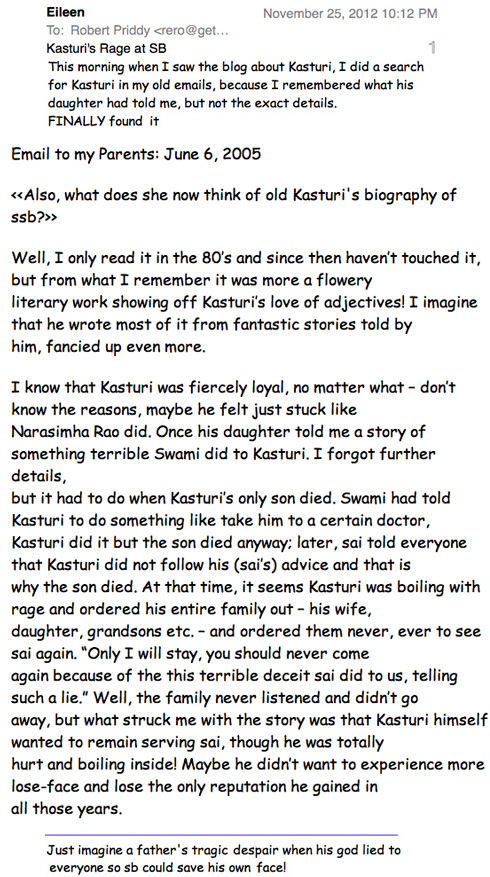 However Kasturi was tested yet further later on and it was nearly the last straw... another incident was more dramatic, nearly causing Kasturi to leave the ashram and reject Sai Baba. It shows how Sai Baba lied to save his own apparent prescience, disregarding entirely the feelings of Kasturi. (see scan on right).
However Kasturi was tested yet further later on and it was nearly the last straw... another incident was more dramatic, nearly causing Kasturi to leave the ashram and reject Sai Baba. It shows how Sai Baba lied to save his own apparent prescience, disregarding entirely the feelings of Kasturi. (see scan on right).
The ‘official’ biography of Sathya Sai Baba, written by Professor N. Kasturi – a very close devotee through decades, recounts stories collected by Kasturi about the many miracles performed by him as a boy and a youth. Prof. N. Kasturi always advises that we concentrate on what is good, not what is bad in other people, and consequently there is not a single hint of criticism or anything untoward in Kasturi’s writings, though some early contemporaries of Sathya give much more credible accounts of his apparently split personality and actions that do not at all fit the polished image now presented to the world. Kasturi’s constant paeans of praise for the young Sai Baba are unlike any proper biography since they are similar in kind and degree to the traditional stories or mythology about Krishna, whom Sathya Sai Baba eventually claimed actually to have been. Kasturi spent some years after coming to Sai Baba’s ashram in Puttaparti village where Sathya was born and lived apart from some periods in nearby places. There he questioned Sai Baba’s remaining family members and many of those who were still alive from the time of Sai Baba’s youth, forming a picture of Sai Baba as a born Divinity who carried out many incredible feats of clairvoyance, healing, and other virtually Biblical acts. Kasturi was in a constant state of wonder – also expressed strongly in the way he recounts those stories, and – being educated and active as a historian and a poet, he acted as a kind of ‘spin doctor’ and even ghost writer’ for Sathya Sai Baba. Much earlier devotees than Kasturi have written their own first-hand reminiscences of the same period – notably Smt. Vijayakumari (Anyatha Saranam Nasthi – Other than You Refuge there is None) and the wholly uncritical reports of his alleged early miracles as either experienced or heard about by Nagamani Purnaiya (The Divine Leelas of Bhagawan Sri Sathya Sai Baba)
(see source materials here).
Professor N. Kasturi was one of the most important editors to influence the mythology of Sai Baba, and his bias was total. He did not allow anything truly untoward to leak out about Sai Baba, though he certainly knew more than most. See The Rumour Mill and its Editors
On such a basis it is obviously extremely difficult to expect any reliably sourced reconstruction of actual events in Sai Baba’s youth from so long ago, especially when there has for decades been a very secretive and huge cordon of servitors closely guarding the privacy of the guru, itself protected by an authoritarian world-wide organisation and a widespread cultist movement protecting Sathya Sai Baba from any kind of untoward reports. Despite the difficulties, what is reported can be reexamined with a critical eye and comparative analyses can be made with parallel events in the religious and social culture of Indian gurus. One approach worth exploring is based on the fairly frequent assertions about Sathya Sai Baba as being born a physical hermaphrodite and about the reported kinds of sexuality he engaged in. An outline of such an approach is outlined in the following article Sathya Sai Baba - an Enigma or a Myth - and claims about his being a hermaphrodite are considered here.
More light has been thrown on the death of Kasturi (reported untruthfully by Sai Baba and embellished falsely by Anil Kumar) as follows:-
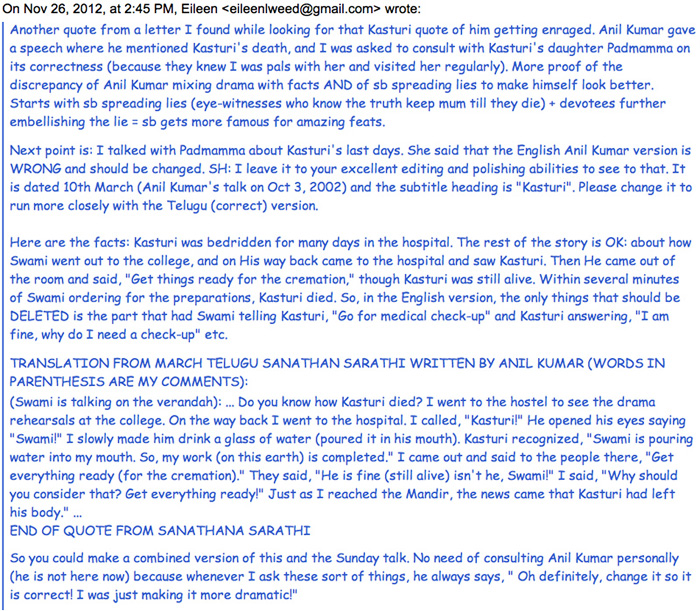
 Commissioned as his official biographer by Sathya Sai Baba, Professor N. Kasturi was his utterly devoted servant and had been a teacher of history to pre-university classes for 32 years and an itinerant poet-cum-public speaker before Sai Baba called him permanently to 'His Feet'. His four-volume work 'Sathyam, Sivam, Sundaram' ( or 'Truth, Goodness, Beauty') begun to be published from 1960 onwards, 12 years after he had moved to the proximity of Sai Baba at his ashrams, living mostly in a tiny and modest apartment allocated to him there until his death. See the scan of text on the right, where Kasturi was explaining how Sai Baba had told US author Arnold Schulman, who wrote a book entitled 'Baba', that he told him to write it only because "I want you. I want your faith. I want your love... it is time now for you to stop vacillating" also "Do you believe in me in the same way I said you
have to believe in me?" p. 75 in 'Loving God') Kasturi applied the same words to himself and concluded "It took twelve years for me to approximate a little to the standard of belief He directs us to have..."
Commissioned as his official biographer by Sathya Sai Baba, Professor N. Kasturi was his utterly devoted servant and had been a teacher of history to pre-university classes for 32 years and an itinerant poet-cum-public speaker before Sai Baba called him permanently to 'His Feet'. His four-volume work 'Sathyam, Sivam, Sundaram' ( or 'Truth, Goodness, Beauty') begun to be published from 1960 onwards, 12 years after he had moved to the proximity of Sai Baba at his ashrams, living mostly in a tiny and modest apartment allocated to him there until his death. See the scan of text on the right, where Kasturi was explaining how Sai Baba had told US author Arnold Schulman, who wrote a book entitled 'Baba', that he told him to write it only because "I want you. I want your faith. I want your love... it is time now for you to stop vacillating" also "Do you believe in me in the same way I said you
have to believe in me?" p. 75 in 'Loving God') Kasturi applied the same words to himself and concluded "It took twelve years for me to approximate a little to the standard of belief He directs us to have..." Kasturi's 'biography' of SSB reads like the systematic application of Hindu iconography to Sathya Sai Baba, which greatly weakens its credibility and will surely be seen mostly as second-hand story-telling by religious scholars and researchers everywhere. The mythology is now beginning to fall apart at the base in that central dates and events have been shown not to be in accordance with official school registers or even with the calendar. These are the kind of facts that are of a fundamental and often conclusive nature for historians and objective researchers of all kinds.
Kasturi's 'biography' of SSB reads like the systematic application of Hindu iconography to Sathya Sai Baba, which greatly weakens its credibility and will surely be seen mostly as second-hand story-telling by religious scholars and researchers everywhere. The mythology is now beginning to fall apart at the base in that central dates and events have been shown not to be in accordance with official school registers or even with the calendar. These are the kind of facts that are of a fundamental and often conclusive nature for historians and objective researchers of all kinds. 

 When the top professional ex-journalist V.K. Narasimhan took over from Kasturi, initially in the early 1980s, he was instructed by Sathya Sai not to publish accounts of dreams, healing powers or other miraculous phenomena... the sort of material in which Kasturi had until then literally revelled in - in Sanathana Sarathi, in his 'biography' of Sathya Sai Baba and in his self-effacing autobiography ('Loving God'). Narasimhan managed to stick to this fairly well, with lapses here and there.
When the top professional ex-journalist V.K. Narasimhan took over from Kasturi, initially in the early 1980s, he was instructed by Sathya Sai not to publish accounts of dreams, healing powers or other miraculous phenomena... the sort of material in which Kasturi had until then literally revelled in - in Sanathana Sarathi, in his 'biography' of Sathya Sai Baba and in his self-effacing autobiography ('Loving God'). Narasimhan managed to stick to this fairly well, with lapses here and there. Thus, Prof. Kasturi showed signs of problems in keeping total trust in Sathya Sai Baba - at least privately. It was apparent from some of his tentative replies that he harboured some doubt about the way Sai Baba explained things... and he wondered what I made of it. I must admit that I was somewhat befuddled and without any good answer. It is well known among those who have had much experience of Sai Baba that his response to those who dared to even suggest a possible discrepancy in what he said or did does was, according to some observers, as if to rise up like a cobra. If he thought he was being confronted, he would avoid being held to account by a wide range of clever diversions. Kasturi never questioned him seriously about sensitive claims, such as his alleged birth date and other such discrepancies. (See text scan here - right - where Kasturi's first impression when meeting Baba on moving to Prashanthi Nilayam in 1948 was that he was much younger than claimed - which sheds new light on the
Thus, Prof. Kasturi showed signs of problems in keeping total trust in Sathya Sai Baba - at least privately. It was apparent from some of his tentative replies that he harboured some doubt about the way Sai Baba explained things... and he wondered what I made of it. I must admit that I was somewhat befuddled and without any good answer. It is well known among those who have had much experience of Sai Baba that his response to those who dared to even suggest a possible discrepancy in what he said or did does was, according to some observers, as if to rise up like a cobra. If he thought he was being confronted, he would avoid being held to account by a wide range of clever diversions. Kasturi never questioned him seriously about sensitive claims, such as his alleged birth date and other such discrepancies. (See text scan here - right - where Kasturi's first impression when meeting Baba on moving to Prashanthi Nilayam in 1948 was that he was much younger than claimed - which sheds new light on the However Kasturi was tested yet further later on and it was nearly the last straw... another incident was more dramatic, nearly causing Kasturi to leave the ashram and reject Sai Baba. It shows how Sai Baba lied to save his own apparent prescience, disregarding entirely the feelings of Kasturi. (see scan on right).
However Kasturi was tested yet further later on and it was nearly the last straw... another incident was more dramatic, nearly causing Kasturi to leave the ashram and reject Sai Baba. It shows how Sai Baba lied to save his own apparent prescience, disregarding entirely the feelings of Kasturi. (see scan on right). 